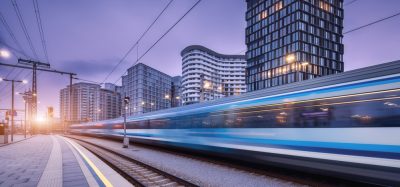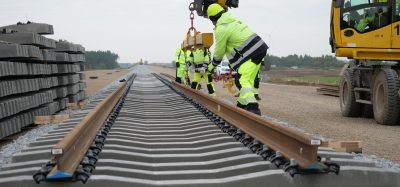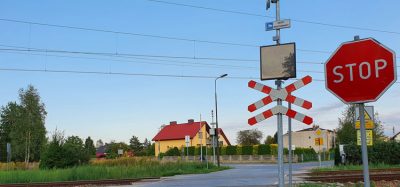Making the capacity case for HS2
Posted: 4 December 2013 | | 1 comment
Britain’s railways are booming. Last year, more than 1.5 billion journeys were made by train and the network moved around 100 million tonnes of goods. But railways do much more than just move people and freight; they connect homes and workplaces, businesses with markets, they create jobs, stimulate trade and support the growth of a balanced economy.
Passenger demand in Britain has increased by 50% over the last decade and this growth is forecast to continue. By 2020 another 400 million journeys are forecast every year. This growth in demand is hugely positive, but the truth is our Victorian railway was never built for this number of trains. We run more on our network each day than Spain, Switzerland, the Netherlands, Portugal and Norway combined and as a result the busiest parts of the network are full at the busiest times of day. Just like a busy motorway, even the smallest of delays can have a big knock-on impact. Performance is at an all-time high but we can’t just keep adding more trains without significantly compromising punctuality.
Nowhere is that trade-off currently more evident than on the West Coast Main Line (WCML) – Britain’s most economically vital rail corridor. It is the busiest mixed-traffic railway in Europe, carrying a quarter of all Britain’s rail freight and hundreds of millions of passengers each year. Twelve operators use the line, with different trains stopping at different stations, at different frequencies and other lines joining it at regular intervals. Train paths are as precious as airport take-off or landing slots and its terminus, London Euston, handles more passengers every day than Gatwick.
Britain’s railways are booming. Last year, more than 1.5 billion journeys were made by train and the network moved around 100 million tonnes of goods. But railways do much more than just move people and freight; they connect homes and workplaces, businesses with markets, they create jobs, stimulate trade and support the growth of a balanced economy. Passenger demand in Britain has increased by 50% over the last decade and this growth is forecast to continue. By 2020 another 400 million journeys are forecast every year. This growth in demand is hugely positive, but the truth is our Victorian railway was never built for this number of trains. We run more on our network each day than Spain, Switzerland, the Netherlands, Portugal and Norway combined and as a result the busiest parts of the network are full at the busiest times of day. Just like a busy motorway, even the smallest of delays can have a big knock-on impact. Performance is at an all-time high but we can’t just keep adding more trains without significantly compromising punctuality. Nowhere is that trade-off currently more evident than on the West Coast Main Line (WCML) – Britain’s most economically vital rail corridor. It is the busiest mixed-traffic railway in Europe, carrying a quarter of all Britain’s rail freight and hundreds of millions of passengers each year. Twelve operators use the line, with different trains stopping at different stations, at different frequencies and other lines joining it at regular intervals. Train paths are as precious as airport take-off or landing slots and its terminus, London Euston, handles more passengers every day than Gatwick.
Britain’s railways are booming. Last year, more than 1.5 billion journeys were made by train and the network moved around 100 million tonnes of goods. But railways do much more than just move people and freight; they connect homes and workplaces, businesses with markets, they create jobs, stimulate trade and support the growth of a balanced economy.
Passenger demand in Britain has increased by 50% over the last decade and this growth is forecast to continue. By 2020 another 400 million journeys are forecast every year. This growth in demand is hugely positive, but the truth is our Victorian railway was never built for this number of trains. We run more on our network each day than Spain, Switzerland, the Netherlands, Portugal and Norway combined and as a result the busiest parts of the network are full at the busiest times of day. Just like a busy motorway, even the smallest of delays can have a big knock-on impact. Performance is at an all-time high but we can’t just keep adding more trains without significantly compromising punctuality.
Nowhere is that trade-off currently more evident than on the West Coast Main Line (WCML) – Britain’s most economically vital rail corridor. It is the busiest mixed-traffic railway in Europe, carrying a quarter of all Britain’s rail freight and hundreds of millions of passengers each year. Twelve operators use the line, with different trains stopping at different stations, at different frequencies and other lines joining it at regular intervals. Train paths are as precious as airport take-off or landing slots and its terminus, London Euston, handles more passengers every day than Gatwick.
As the route gets more congested it gets harder to recover from delays. Something as simple as a blown fuse bears comparison to a breakdown on the motorway – it might be fixed quickly but there are tailbacks for the rest of the morning. We have invested heavily, lengthening platforms to enable longer trains to operate and will deliver further upgrades to untangle bottlenecks and improve performance. But in the longer term, demand will still outstrip supply. We know that. Even now, at the busiest times of day, there is no more space to run additional services into London Euston without causing knock-on delays to others on the route – and the trains that do run see significant levels of overcrowding.
We predict the number of commuters arriving at Euston will grow by 26% between 2011 and 2023, but we cannot create enough train paths to run the extra services required. By the mid-2020s, both the trains and the line will be full. The effects will be felt at the southern end first, with many commuters unable to board their trains at the busiest times, before similar problems start to affect longer-distance passengers. Although capacity is most con strained at the southern end of the line, long distance trains are often overcrowded, usually outside of the London commuter peaks. Between 2011 and 2023, we expect demand to grow between London and Manchester by up to 46% and even the most pessimistic scenario predicts that London to Birmingham passenger numbers will grow by a third within 30 years.
So what can we do to create the capacity we need for the future? Our 2009 ‘New Lines’ study examined the capacity challenge on the West Coast Main Line in detail. It concluded that the gap between available capacity and future demand was so great that upgrades alone would not be enough. Only new running lines could meet long-term demand and highspeed lines would provide better value for money. The government subsequently created a company, HS2 Ltd, to bring forward proposals for a new line.
HS2 is one of the few issues which enjoys a broad political consensus among our three major political parties and the current government has worked hard to advance legislation which lays the groundwork for construction to start within the next few years. For many of us, HS2 is a no-brainer – the only practical answer to a very real capacity crisis which would, left unchecked, stifle economic growth and hurt communities the length of Britain.
But we must also accept that there are many people in this country – including members of parliament, council leaders, business people and various media ‘comm – entators’ – who believe that HS2 is an unnecessary extravagance. Some have called it a political vanity project. They say that the necessary capacity can be provided by lengthening trains and upgrading the existing infrastructure. It can’t.
In 2011, we were asked by the Department for Transport (Dft) to review specific proposals which sought to demonstrate that upgrades alone could meet demand – Atkins’ Rail Package 2 and the ‘Optimised Alternative’ created by 51M, a coalition of local authorities opposed to the construction of a new line.
The 51M proposal suggests declassifying first class carriages, lengthening trains and upgrading infrastructure on the WCML in a number of areas. Our report found that whilst the proposals do have the potential to increase capacity (albeit at greater cost and with more disruption than had been assumed) they would only deliver a shortterm benefit. Even if all the upgrades could be delivered, by the mid-2030s load factors on commuter services would be back at 122% and you would still need to build a new line. In contrast to continued piecemeal upgrades, High Speed 2 will provide a step-change in capacity on the WCML.
Phase 1 between London and Birmingham, which it is hoped will be operational by 2026, will create the extra train paths we need to run more commuter services as well as provide more space for freight. An initial study carried out by Network Rail into how these train paths might be used showed that fast-growing commuter towns at the southern end of the route could get more trains an hour at peak times and a much better chance of a seat for commuters. Other places could see quicker journeys and new direct services. Milton Keynes, for example – which has seen a 26% increase in passenger numbers in the last five years alone – will be a major beneficiary, with up to 12 trains an hour to London Euston (currently six) and a journey time reduction of up to a third, as well as better connections to the West Midlands and neighbouring towns. Crucially, all passengers would have a reasonable expectation of a seat, even at the busiest times of day.
Phase 2, which will connect Birmingham with Manchester and Leeds, will not only relieve capacity constraints further north, it could also see the rail network reshaped to deliver a step-change in connectivity, bringing key towns and cities closer together to help drive economic growth.
A further initial study into how you might use the capacity freed up by the completion of the second phase of HS2 highlighted three possible approaches to its integration. The first was a ‘do minimum’ approach, which would keep train services on existing lines broadly the same, offering reduced crowding and increased choice for passengers between high-speed and conventional long-distance services at certain locations. The second was an ‘incremental’ approach, which seeks to replace long-distance services on the existing network which are replicated by those provided by HS2, allowing the capacity to be used for improved inter-urban connectivity and/or additional commuting capacity. The third was a more radical approach which we termed ‘integrated connectivity’ – an exciting concept which would see all future rail services planned in a ‘hub and spoke’ model to complement and work in conjunction with HS2.
Even the incremental approach identified potential benefits for over 100 towns and cities across Britain, although the integrated conn – ectivity approach was supported by the majority of stakeholders – local authorities, passenger transport executives and chambers of commerce – who helped us to produce the report.
We will follow up both these reports with more detailed assessments in due course. It is hugely important that we continue to work with these stakeholders to consider and plan future rail services to make the best use of the capacity on both high-speed and existing lines. HS2 provides the kind of opportunity which doesn’t come along often – to make strategic, wellevidenced decisions about the kind of rail service we want for the future.
Let me be clear; HS2 will not solve all of the problems facing Britain’s congested railway. We will still need to continue investing, improving, upgrading the network to squeeze ever more out of our ageing assets. Indeed, Network Rail is investing around £5 billion a year in renewing and upgrading the railway, and by 2019 we will have provided 170,000 extra commuter seats at peak times, expanded London’s rail capacity by 20% and provided space for 700 more trains a day across the north of England.
But in some places that will not be enough. The challenge facing commuters at the southern end of the WCML in a decade’s time will not be getting a seat, but getting on the train in the first place. The only answer to a railway running out of space but facing huge demand is sustained strategic rail investment to build new capacity on the network and boost connectivity between Britain’s towns and cities.
HS2 is a big decision. It is daunting both in its scale and ambition. And, I fully accept, there are big questions that will have to be answered along the way. But the prize is big too – a chance to escape the constant frustration of bending every sinew just to play catch up in a game you can never win, no matter how hard you try. This is our chance to move beyond that frustration and, for once, to get ahead of the game.
Biography
As Head of High-Speed Rail Development, Rupert Walker is leading Network Rail’s involvement in the development and delivery of Britain’s high-speed rail strategy. Rupert and his team work closely with DfT, HS2 Ltd and other stakeholders to inform and develop the Government’s plans and make sure that High Speed Two is integrated with the wider network. Bringing together people with expertise and experience from across Network Rail, including projects such as Crossrail, King’s Cross, West Coast Route Modernisation and Birmingham Gateway, Rupert’s team is working closely with local route team colleagues and the broader business so that the value Network Rail adds to this exciting project is maximised, and the railway continues to evolve and provide vital support for Britain’s economy. Rupert joined the railways in December 2000 and has led the development of projects including Thameslink, Reading, Crossrail and ERTMS. His ambition is to ride a high-speed train on the new line from London to Manchester before his retirement!
OUT NOW: The Definitive Guide to Rail’s Digital Future
The rail industry is undergoing a digital revolution, and you need to be ready. We have released our latest market report, “Track Insight: Digitalisation.”
This is not just another report; it’s your comprehensive guide to understanding and leveraging the profound technological shifts reshaping our industry. We move beyond the buzzwords to show you the tangible realities of AI, IoT, and advanced data analytics in rail.
Discover how to:
- Optimise operations and maintenance with real-time insights.
- Enhance passenger services through seamless, high-speed connectivity.
- Leverage technologies like LEO satellites to improve safety and efficiency.
Featuring expert analysis from leaders at Nomad Digital, Lucchini RS, Bentley Systems and more, this is a must-read for any rail professional.








HS2 — at last! Britain stands a chance to catch up with the rest of the world.
With one reservation, however. The double-track line between London and Birmingham cannot possibly hold all of Britain’s high-speed traffic! Even 20 train paths per hour will not make it, by 2035 at the latest. Will you then start thinking of another line northwards from London, threading through the even more crowded country? Much too late.
Either you start with a four-track line (across the Chilterns!) or you build one more HS line towards Leeds etc., maybe five years later than HS2.
Good luck!